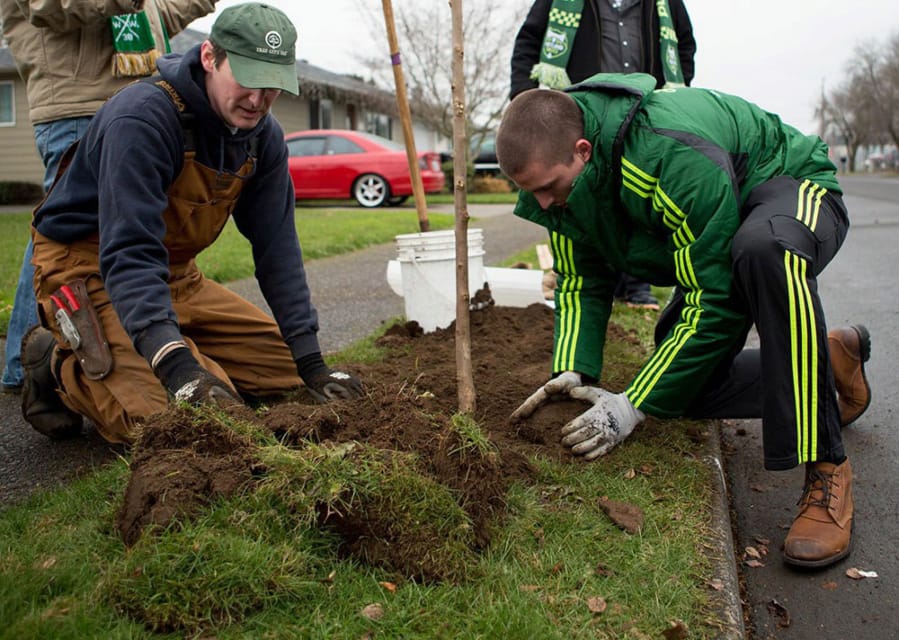Every once in a while, a volunteer outing comes along that seems too easy, too neighborly — and too crucial to the health of our world — not to participate.
All you need to do is show up by 8:45 a.m. Saturday at East Woods Presbyterian Church, dressed for weather and mud, to help the busy nonprofit agency Friends of Trees save the planet this spring.
The plan for that morning is to fan out and plant upwards of 100 trees across a huge swath of private property — yards and street-side planting strips — in east Vancouver. The following east-side neighborhood associations will be covered: Airport Green, Burnt Bridge Creek, Burton-Evergreen, Cimarron, Countryside Woods, Fircrest, First Place, Hearthwood, Image, Kevanna Park, Landover-Sharmel, North Hearthwood, North Image, Parkside and Parkway East. That’s nearly all of Vancouver north of Mill Plain between I-205 and the city’s eastern boundary.
There’s actually a little fine print for some volunteers. If you’re in a group of six or more, please RSVP via the Friends of Trees website; if you’re under 18, you’ll need a signed waiver; if you’re under 15, you’ll need an adult. And, if you’ve got a pickup truck, organizers would love to know ahead of time.
IF YOU GO
What: Northeast Neighborhoods Tree Planting
When: Arrive by 8:45 a.m., planting runs 9 a.m.- 1 p.m. March 24.
Where: Meet at East Woods Presbyterian Church, 16210 N.E. 20th St., Vancouver.
Don’t forget: Wear boots or sturdy shoes. Dress for weather and dirt.
Cost: Free, but unaccompanied volunteers under 18 need a signed youth waiver. No unaccompanied volunteers under 15.
Youth waiver: Go to the Friends of Trees website and click on “How to Volunteer.”
On the web: friendsoftrees.org
• • •
What: Final planting in Clark County this season on April 7, covering: Felida, North Salmon Creek, West Hazel Dell.
Where: Meet at SixEight Church, 8802 N.W. Ninth Ave, Vancouver.
Sturdy boots or shoes are mandatory, but Friends of Trees will provide gloves and tools. After planting, local volunteers will provide a potluck lunch. Is there a better way to get to know your fellow neighborhood tree lovers?
The tree starts have all been purchased at a steep discount via Friends of Trees’ nonprofit, underwritten prices; $35 per tree is typical, but the group always works with folks who can’t afford that. Its website features a handy, interactive, visual guide to picking the right tree for the right location — complete with space and size requirements, best growing conditions and aesthetic characteristics — and a consultation with a tree expert is available, too.
This year may be young, but the tree-planting season is already wrapping up. After Saturday, one more Friends of Trees volunteer outing is scheduled for this spring: April 7 in the Felida, West Hazel Dell and North Salmon Creek neighborhoods. The planting cycle will begin again — covering the entire city of Vancouver in quadrants, as well as unincorporated areas of Clark County — in late fall.
“Our planting season is November through April, as this is the ideal time to plant as trees are in dormancy,” said neighborhood tree specialist Megan Van de Mark. “After that we turn our focus toward young tree care maintenance for the summer.”
Friends of Trees is always looking for volunteers in other roles too, Van de Mark said — including summer tree inspectors but especially neighborhood coordinators, who help spread the word about the program.
Benefits of trees
According to the latest available data, Vancouver’s urban tree canopy covered 18.6 percent of the land area in town in 2011. That was a decline of about one percent from a previous survey, conducted not even a decade earlier. But, the canopy coverage target for Pacific Northwest urban areas recommended by American Forests, a research and advocacy agency that advises the U.S. Forest Service, is 40 percent.
Why? The more trees you’ve got, the healthier your community is in a number of ways. Trees stabilize soil and reduce erosion, flooding and runoff pollution by catching rainfall before it hits the ground, or drinking it up afterwards; the average tree also absorbs 10 pounds of pollutants from the air per year while pumping out 260 pounds of oxygen. Trees buffer heat and wind and have been shown to reduce home heating and cooling costs dramatically. Trees provide habitat for birds and animals.
And, trees make urban living nicer by dampening noise and adding beauty. Merchants know that tree-lined business districts attract more customers; real estate agents know that leafy neighborhoods command higher prices than bare ones. Medical science has found that being surrounded by trees reduces people’s blood pressure and stress hormones, making them feel less stressed-and-depressed overall.
All of which is why Vancouver is now working toward an “achievable goal” of 28 percent tree canopy coverage, according to urban forester Charles Ray. “In order to reach 28 percent, we are partnering with neighborhoods, businesses, community groups and individuals to plant and care for trees,” Ray said. “Every tree counts, whether it is in a commercial district or a residential backyard. The simple truth is, healthy urban forests are critical to the health of a community.”
How’s progress toward achieving that goal? “With the amount of development that is occurring, it feels like we are breaking even,” Ray said.
Vancouver’s 2011 canopy survey mentioned that, despite an overall decrease in canopy coverage, some west-side neighborhoods bucked the trend by working with Friends of Trees. The same sorts of canopy improvements have been so dramatic in Portland that the phenomenon there has been dubbed the “Friends of Trees Effect.”
“A healthy urban forest doesn’t happen by chance,” Ray said. “A healthy urban forest is the result of proper planning, management, community investment, and involvement.”




